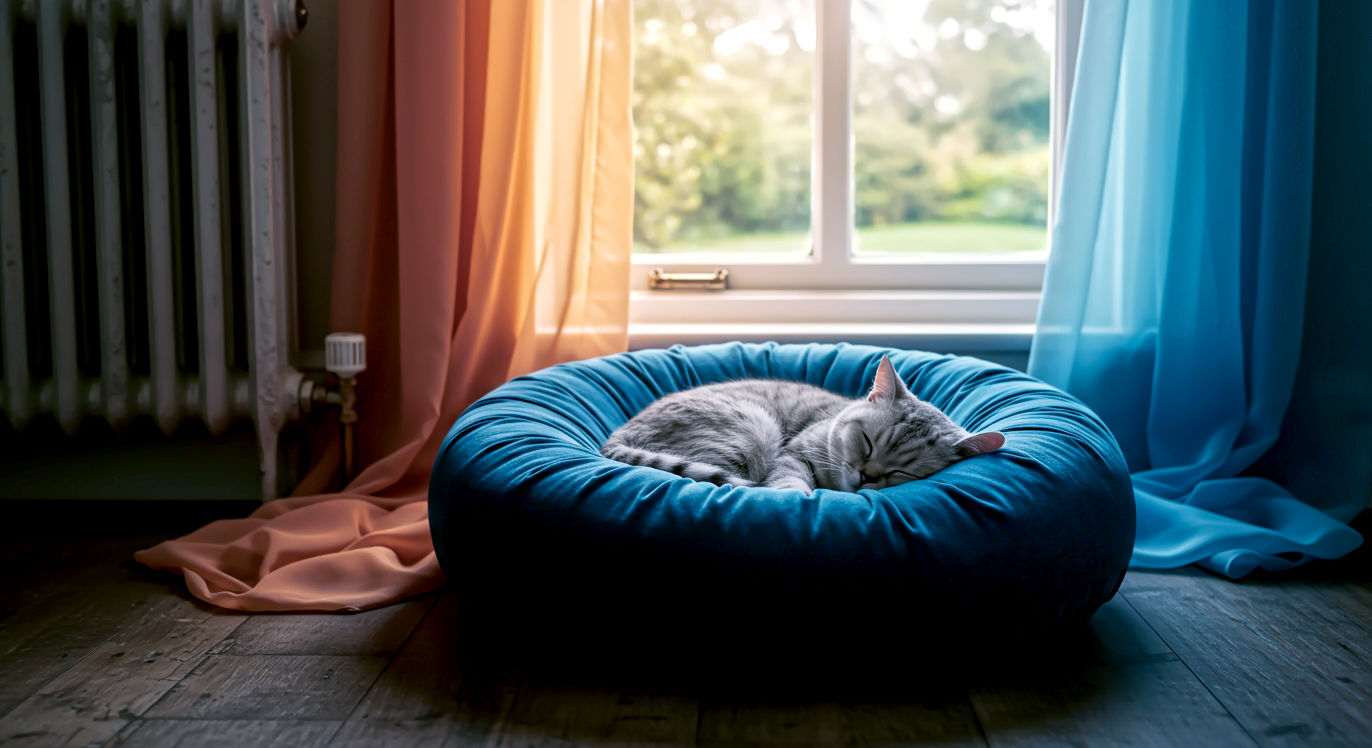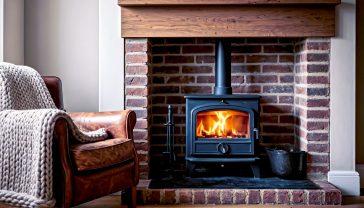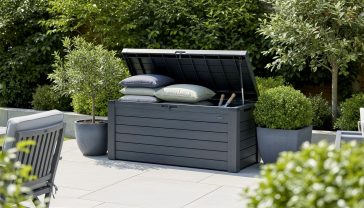The Guide to Cat Beds: Finding the Perfect Perch for Your Feline Friend
Discover the perfect bed for your feline friend. This definitive guide explores every type, from cosy radiator beds to supportive orthopaedic mats.

This post may contain affiliate links. If you make a purchase through these links, we may earn a commission at no additional cost to you.
Picture this: a classic British scene. Rain is lashing against the windowpanes, the wind is howling a bit, and a fire is crackling merrily in the hearth. And right there, in the best spot in the house, a cat is curled up, dead to the world in a deep, contended sleep. It’s an image of pure comfort and domestic bliss. But what is it sleeping on? Is it your favourite armchair? A pile of clean laundry? Or is it in a bed designed just for them?
For many cat owners across the UK, buying a dedicated cat bed can feel like a bit of a gamble. We’ve all been there: you spend ages picking out the perfect, plush little bed, bring it home with excitement, and present it to your feline majesty… who gives it a sniff, turns their nose up, and goes back to sleep in the cardboard box it came in. It’s a classic cat move.
But don’t be put off. A good cat bed isn’t just a fluffy accessory; it’s a vital piece of kit for a happy, healthy, and secure cat. It’s their safe space, their warm retreat, and their personal territory in a busy human world. This guide is here to walk you through everything you could possibly need to know about cat beds. We’ll explore why they’re so important, take a tour of all the different types (including that very British classic, the radiator bed), and give you practical tips to make sure you choose a bed your cat will actually use. So, grab a cuppa, let the cat settle on your lap (for now), and let’s get started.
Why Do Cats Even Need Their Own Beds?
It’s a fair question. Cats seem perfectly capable of finding comfortable spots to sleep without our help. Your bed, the sofa, that sunbeam on the rug—they’re masters of comfort. But a dedicated bed of their own offers unique benefits that these temporary spots can’t match.
A Slice of Their Own Territory
Cats are territorial creatures. In the wild, having a safe, predictable den is crucial for survival. Our domestic cats still have these instincts hard-wired into them. A cat bed is essentially their own little flat. It’s a space that smells exclusively of them, where they can retreat and feel completely secure. This is especially important in a multi-pet household, where a personal bed can reduce stress and conflict by giving each animal its own defined space. It’s their safe haven, a place where they know they won’t be disturbed.
The Quest for Warmth and Comfort
Cats are expert heat-seekers. Their ideal resting body temperature is higher than ours, which is why they’re drawn to sunny spots, laptops, and radiators. A good cat bed is designed to conserve body heat. Insulating materials trap warmth, keeping your cat cosy and comfortable, especially during a chilly British winter in a draughty old house. This helps them maintain their body temperature without having to burn extra energy.
Supporting Health and Wellbeing
A proper bed provides more than just warmth; it offers crucial physical support. This is particularly important for older cats or those with arthritis. An orthopaedic cat bed with memory foam can cushion joints, relieve pressure points, and make a world of difference to a senior cat’s comfort and mobility. Even for a young, healthy cat, a supportive bed helps maintain good posture and ensures a truly restorative sleep. And we all know that a well-rested cat is a happy cat.
The Grand Tour: A Look at Every Type of Cat Bed
The world of cat beds is surprisingly vast. From simple mats to futuristic heated pods, there’s something for every personality and every home. Let’s explore the most popular options you’ll find in the UK.
The Radiator Bed: A Very British Favourite
You won’t find this in many other countries, but in the UK, the radiator bed is a stroke of genius. It’s a small, hammock-like bed with a sturdy wire frame that hooks securely over a standard radiator.
- Who’s it for? The heat-seeking cat who loves to be warm and off the ground. It’s perfect for cats who are always trying to sleep on top of the boiler or in the airing cupboard.
- Pros: Incredibly warm and cosy, saves floor space, and gives your cat a great vantage point to survey their kingdom from.
- Cons: Only useful when the heating is on, and you need to make sure it’s securely fitted and away from any curtains.
The Cave or Igloo Bed: For the Cautious Cat
A cave bed is exactly what it sounds like: a soft, enclosed bed with a small opening. It looks like a little fabric igloo or tent.
- Who’s it for? Shy, nervous, or timid cats who feel safer in a confined space. It mimics the feeling of a natural den, providing a sense of security and privacy. It’s also a great choice for households with boisterous children or dogs.
- Pros: Offers excellent security and warmth. The enclosed design helps to muffle sound and block out drafts.
- Cons: Can be harder to clean inside, and some more confident cats might find it too restrictive.
The Donut or Calming Bed: A Modern Marvel for Anxious Paws
These have become hugely popular in recent years, and for good reason. A donut bed is a round, plush bed with raised, fluffy sides. It’s often made from super-soft faux fur.
- Who’s it for? Cats who love to curl up and knead, and especially those who suffer from anxiety. The raised rim provides a sense of security and supports their head and neck, while the soft texture is thought to mimic the feeling of cuddling up to their mother and littermates.
- Pros: Extremely comfortable and comforting. The design promotes a calming effect, helping to ease anxiety. They also look incredibly cosy.
- Cons: The long faux fur can be a magnet for dirt and hair, so check if the cover is machine-washable.
The Orthopaedic Bed: Comfort for the Golden Years
As our cats get older, they can suffer from aches and pains just like we do. Arthritis is common in senior cats, and a hard surface can be very uncomfortable.
- Simplified Explanation: Think of it as a super-supportive mattress for your cat. Instead of sinking right through, the special foam shapes itself to their body, taking the pressure off sore joints.
- Detailed Explanation: An orthopaedic bed is typically made from a slab of high-density memory foam. This material responds to body heat and pressure, contouring to the cat’s exact shape. This distributes their weight evenly, which helps to alleviate pressure on the hips, shoulders, and spine.
- Who’s it for? Senior cats, cats with arthritis or joint problems, or larger, heavier breeds.
- Pros: Provides outstanding support, improves comfort, and can help to improve sleep quality for cats in pain.
- Cons: They are usually more expensive than standard beds and can be quite firm, which not all cats enjoy.
The Heated Cat Bed: A Toasty Treat for Winter
This is the next level up from a radiator bed. A heated bed or pad contains a low-voltage heating element that gently warms the surface.
- Who’s it for? Elderly cats, kittens, cats recovering from illness, or any feline who simply loves to be as warm as possible. It’s particularly good for thin cats who feel the cold more.
- Pros: Provides consistent, gentle warmth. Modern versions are very safe, with low power usage and thermostats to prevent overheating.
- Cons: Needs to be plugged in, so you’re limited by socket locations. Always buy from a reputable brand and check for safety certifications.
The Window Perch: A Room with a View
For the nosy cat who loves to watch the world go by, a window perch is the ultimate entertainment centre. These are shelves or hammocks that attach directly to a window or windowsill, usually with strong suction cups or brackets.
- Who’s it for? Indoor cats who crave stimulation. It gives them a front-row seat to watch birds, people, and traffic, which can help to prevent boredom.
- Pros: Mentally stimulating and provides a lovely sunbathing spot. Doesn’t take up any floor space.
- Cons: You need a suitable window, and you must check the weight limit and the strength of the suction cups regularly to prevent any accidents.
The Classic Bolster Bed: Simple, Secure, and Stylish
This is probably what most people picture when they think of a cat bed. It’s an oval or rectangular bed with raised, cushioned sides (the bolster).
- Who’s it for? Almost any cat! It’s a great all-rounder. The raised sides are perfect for cats who like to lean on something or rest their head, providing a sense of security without being fully enclosed.
- Pros: Comes in countless styles, materials, and sizes to match any home decor. The design is versatile and appeals to most cats.
- Cons: Pretty much none! It’s a can’t-go-wrong option.
The Luxury Lounger: For the Pampered Prince or Princess
For some, only the best will do. The luxury cat bed market has exploded, with beds that are basically miniature, designer human sofas or armchairs. They’re made from high-end materials like velvet, real wool, or even leather.
- Who’s it for? The cat who has everything, and the owner who wants their pet’s furniture to be a stylish statement piece.
- Pros: Beautifully designed and made from premium materials.
- Cons: The hefty price tag. And there’s still no guarantee your cat won’t prefer the box it was delivered in!
Materials Matter: What’s Your Cat’s Bed Made Of?
The material of a cat bed affects its comfort, durability, warmth, and how easy it is to clean. Here’s a quick rundown of the most common options.
Soft and Snuggly: Fleece, Faux Fur, and Sherpa
These are the most popular materials for a reason. They are incredibly soft, warm, and great for trapping body heat. Cats love the plush texture and will often knead on these materials contentedly. Most are synthetic, which makes them durable and generally machine-washable. Their main job is to provide maximum cosiness.
Natural and Breathable: Cotton, Wool, and Wicker
Natural fibres are another excellent choice. Cotton is breathable and hypoallergenic, making it a good option for cats with sensitive skin. Wool, particularly merino wool, is fantastically soft, naturally temperature-regulating (warm in winter, cool in summer), and has antimicrobial properties. Wicker or rattan beds look stylishly rustic, but they absolutely need a soft cushion inside to be comfortable.
Thinking Green: Eco-Friendly and Sustainable Options
Many owners are now looking for more sustainable pet products. Look for beds made from recycled materials, such as fillings made from recycled plastic bottles. Organic cotton, hemp, and sustainably sourced wool are also fantastic eco-friendly choices that are both good for the planet and perfectly safe for your pet.
How to Choose the Perfect Cat Bed: A Practical Checklist
Right, you’ve seen the options. Now, how do you pick the right one? Don’t just go for the one you think looks prettiest. Think like a cat.
1. Size and Shape: Does it Fit Your Feline?
This is the most important step. Before you buy, watch how your cat naturally sleeps.
- The Curler: Does your cat sleep curled up in a tight little ball? A round or oval bed, like a donut or bolster bed, will be perfect. It will make them feel snug and secure.
- The Stretcher: Does your cat love to sprawl out, stretching their legs in all directions? They’ll need a larger, rectangular bed or a simple mat that gives them plenty of room. Measure your cat while they’re sleeping to get a rough idea of the size you need. The bed should be big enough for them to be comfortable, but small enough to feel snug. A bed that’s too big won’t feel as secure.
2. Personality Profile: Matching the Bed to the Cat
- A Confident Cat who likes to be in the middle of the action might love a bolster bed or a window perch placed in a busy room.
- A Shy Cat who hides when visitors come over will almost certainly appreciate the privacy and security of a cave bed placed in a quiet corner.
- An Anxious Cat could really benefit from the comforting hug of a calming donut bed.
3. Age and Health Considerations
- Kittens: They have lots of energy but also sleep a lot. A small, soft, and importantly, washable bed is ideal. A heated pad can also help mimic the warmth of their mother.
- Adult Cats: Most adult cats will be happy with any of the options we’ve discussed, as long as it matches their size and personality.
- Senior Cats: Comfort and support are key. An orthopaedic bed is the gold standard. Also, choose a bed with a low entrance so it’s easy for them to get in and out without having to jump.
4. The Human Factor: Ease of Cleaning
Let’s be realistic. Cat beds get covered in hair, drool, and occasionally, worse. A bed that is a nightmare to clean will quickly become a problem. Look for beds with removable, machine-washable covers. This is a non-negotiable feature for most owners. Beds that are fully machine-washable are even better. Always check the washing instructions before you buy.
Location, Location, Location: Where to Place the Bed for Maximum Use
You can buy the most luxurious, perfect cat bed in the world, but if you put it in the wrong place, your cat will ignore it. Finding the right spot is just as important as choosing the right bed.
The “Multi-Bed” Household
Many cat behaviourists recommend having more than one bed, especially in a larger house. This gives your cat choices depending on their mood, the time of day, or where the family is gathered. Think about having one bed in a quiet, private spot for deep sleep, and another in a more social area, like the living room, for when they want to snooze but still be part of the action.
High vs. Low: Understanding Your Cat’s Preference
Some cats are ‘tree dwellers’ who feel safer up high. For them, a window perch, a radiator bed, or even a bed placed securely on a sturdy chest of drawers will be a hit. Other cats are ‘bush dwellers’ who prefer to stay grounded. They will feel more secure in a cave bed tucked behind the sofa or under a table.
Sun Worshippers and Heat Seekers
Pay attention to where the sunbeams fall in your house throughout the day and try placing a bed there. It’s a guaranteed way to make a spot more attractive. And as we know, anywhere near a source of warmth is prime real estate for a cat. A spot near a radiator (but not so close that the bed overheats), a fireplace, or an Aga is always a good bet. The key is to choose a spot that is warm, draught-free, and feels safe.
The Great Refusal: What to Do When Your Cat Ignores the Bed
So you’ve done everything right, and your cat still prefers the Amazon box. Don’t despair! This is incredibly common. Here are a few tricks to gently persuade them that their new bed is, in fact, brilliant.
The Irresistible Lure of the Cardboard Box
Why do they do it? It’s not just to spite you. A cardboard box is a fantastic insulator, and its four walls provide a sense of security that appeals to a cat’s predatory instincts—it’s the perfect hiding spot. The new bed, by contrast, smells strange and unfamiliar.
Making the New Bed Feel Like Home
The goal is to make the new bed smell familiar and safe.
- Scent Swapping: Take a blanket or t-shirt that your cat has already slept on and place it in the new bed. You can even take a soft cloth, gently rub it around your cat’s cheeks (where their scent glands are), and then wipe the cloth all over the new bed. This transfers their personal scent, effectively claiming it as their territory.
- Positive Reinforcement: Place a few of their favourite treats in the bed, or sprinkle a little bit of catnip inside. Play with them near the bed using a wand toy, encouraging them to pounce into it during the game.
- Location Swap: If your cat has a favourite (but inappropriate) sleeping spot, try placing the new bed directly on top of it. Once they start using it, you can gradually move it to a more desirable location.
Patience is a Virtue
Don’t force your cat into the bed. This will only create a negative association. Just make the bed as appealing as possible and then leave them to it. It might take days or even weeks, but one day, you’ll likely walk into the room and find them curled up inside, as if it was their idea all along.
Keeping It Clean: A Guide to Cat Bed Hygiene
A clean bed is essential for your cat’s health. A dirty bed can harbour fleas, germs, and unpleasant odours. Aim to wash your cat’s bedding at least every couple of weeks, or more often if it gets visibly dirty.
- De-hair it first: Before you put it in the machine, use a vacuum cleaner, lint roller, or a damp rubber glove to remove as much cat hair as possible.
- Use pet-safe detergent: Avoid strong-smelling detergents or fabric softeners, as the powerful scent can be off-putting for cats. Look for non-bio, fragrance-free options.
- Wash at a high temperature: A 60°C wash is usually recommended to effectively kill germs and flea eggs, but always check the bed’s care label first.
Feeling Crafty? The Joy of a DIY Cat Bed
You don’t have to spend a lot of money to give your cat a comfy spot. If you’re feeling creative, a DIY bed can be a fun and rewarding project.
- The Old Jumper Bed: Take an old woolly jumper, stuff the body and arms with soft material (like old pillows or more clothes), and then sew the neck and waist closed. Finally, curl the arms around and stitch them to the body to form the bolster sides. It’s quick, easy, and will already smell of you, making it extra appealing to your cat.
- The Cardboard Box Creation: Embrace the box! Take a sturdy cardboard box, cut a doorway in the side, and make it comfortable by lining it with a soft blanket, a folded towel, or an old pillow. Simple, yet almost always a winner.
The Future of Feline Furniture: What’s Next for Cat Beds?
The world of pet products is always evolving. We’re already seeing ‘smart’ pet beds that can heat or cool themselves based on the ambient temperature. As sustainability becomes more important, we’ll likely see even more beds made from innovative, eco-friendly materials. We may even see beds with built-in sensors that monitor a cat’s sleep patterns to help track their health. But no matter how high-tech they get, the fundamental principles will remain the same: a great cat bed must be safe, warm, and comfortable.
Conclusion: The Perfect Bed is a Happy Cat
Choosing a cat bed isn’t just about buying a product; it’s about understanding your cat’s unique needs, personality, and quirks. It’s an act of love. By observing how they sleep, where they like to relax, and what makes them feel secure, you can provide them with a little haven that is truly their own.
Don’t be discouraged if your first attempt is met with feline indifference. Patience and a little bit of cat-centric thinking will get you there. And when you finally see your cat curled up, purring contentedly in the bed you chose just for them, you’ll know you’ve got it sorted. You’ve given them more than just a place to sleep; you’ve given them a place to call home.
Further Reading
For more expert advice on cat care and behaviour, please visit these highly respected resources:
- Cats Protection: https://www.cats.org.uk/help-and-advice
- RSPCA (Royal Society for the Prevention of Cruelty to Animals): https://www.rspca.org.uk/adviceandwelfare/pets/cats
- International Cat Care: https://icatcare.org/advice/






